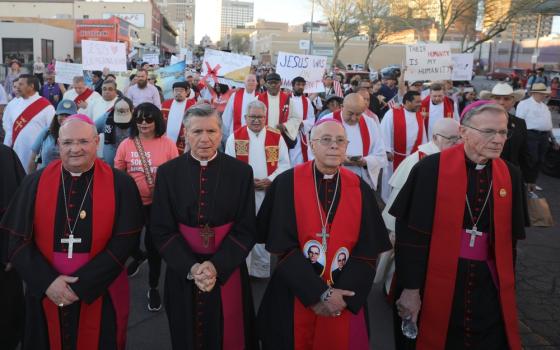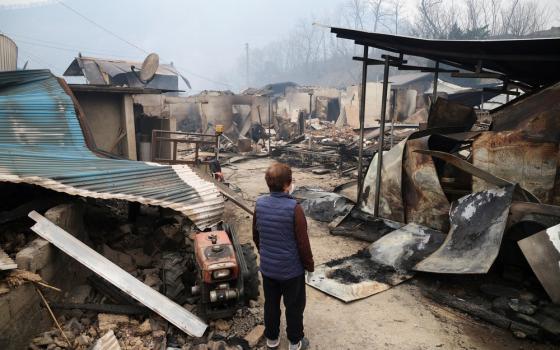It is rare that one encounters a book that is seminal, well written and important, all at the same time. But, Lost Classroom, Lost Community: Catholic Schools’ Importance in Urban America, by Margaret Brinig and Nicole Stelle Garnett is such a book. It sets forth a new argument for keeping our Catholic schools vibrant, and instantly makes itself a “must read” for every bishop, every school superintendent, event director of a state Catholic conference, every lobbyist for Catholic conferences, as well as anyone, Catholic or not, who cares about bringing relief to the often miserable conditions that confront urban America.
Brinig and Garnett’s thesis is straightforward. There is plenty of documentation about the success of Catholic schools for those students who attend them. They have higher graduation rates. More of their students get into college and more of them graduate. Down the road, those students are likely to have more stable marriages, better jobs, be more involved in their community, in short, they will acquire higher levels of “social capital” than those students who attend often failing public schools in urban America. That we all knew. But, what Brinig and Garnett ask and answer is whether or not a Catholic school has an appreciable effect on the social capital of the neighborhoods they serve, not just the students. And, the answer is yes, they do, and the effect is not only appreciable, it is positive.
Brinig and Garnett look at lists of school closings in the city of Chicago and then compare that data with data relating to various indices of social capital. Mercifully, they keep the necessary statistical predicates to their work to a minimum: In a peer reviewed book like this, setting forth the statistical analysis can often bog down a book, but these authors relate the relevant information and move on to the significance of the statistics. And, what those statistics demonstrate is that if a Catholic school closes in an urban neighborhood, various indicators of increased social disorder are going to go up, including the crime rate. For example, while crime fell in Chicago between 1999 and 2005 by 25 percent in most police beats in the city, it only fell by 17% in those neighborhoods where a Catholic school closed. Each of those crime percentage points represents a life lost, a woman assaulted, a business broken into. Behind the statistics are real lives. As well, there is yet no data to suggest that public charter schools have a similar positive effect on building social capital in the neighborhoods they serve, although, as the authors allow, there is a bit of an apple and orange comparison here as most charter schools are relatively new and many urban Catholic schools have been neighborhood anchors for years.
The authors demonstrate a thorough familiarity with the vast literature on urban life. For example, there is an extended treatment of the “broken windows” hypothesis that suggests crime prevention must focus not only on solving violent crime, but must attend to prosaic concerns as well because a neighborhood filled with broken windows suggests no one much cares about the value of property, no one is looking out for the neighborhood and it is not difficult to presume that such a neighborhood would strike a potential burglar as prime real estate for their crimes. Brinig and Garnett also examine the work of Robert Sampson and Stephen Raudenbush on the effects of perceived social disorder in Chicago neighborhoods. And, to check their work on Chicago, they also examine school closings in Philadelphia and Los Angeles, and the relationship of those closings to a decrease in social capital. Interestingly, in Philadelphia, the data tracked with Chicago but it didn’t in Los Angeles which the authors suspect is attributable to the different urban landscape of sprawling Los Angeles as well as the very different approach to locating churches and schools employed by the archdiocese of Los Angeles in years past.
Along the way, there are other very interesting pieces of information. It is not surprising that an increase in the poverty rate in the ambient neighborhood strongly correlates with school closures. It is also not surprising that leadership by the pastor is the leading reason Catholic schools stay open. For example, “many schools closed when a long-standing pastor reached retirement age and a new priest, who did not share his predecessor’s long history with the school, became pastor at the parish and school,” they write. “Indeed, about 22 percent of the closed schools [in Chicago] had pastors in their first year of service to the parish when the school closed.” It is also not surprising, but it had not occurred to me, that the long, ugly shadow of the sex abuse scandal is felt in assessing the reasons parish schools close. “Finally, the factor that most predicted that a school would close – more so than income or race – was whether there was something ‘irregular’ about the parish leadership,” they write. Not all the “irregularity” was due to having a priest who abused children; some merely had a parish administrator for other reasons. Nonetheless, the numbers are startling. “Schools affiliated with these troubled parishes….were ten times more likely to close as healthy parishes led by pastors in regular rotation.”
The book does not explicitly raise the question – but I will. Is it not past time for our Catholic leadership to realize we need a different model of school governance? With all the many challenges facing a pastor, with all the demands on his time, why should we expect someone with all the gifts of a good pastor to also have those gifts needed to lead a school? We all know gifted priests who love their people, preach with passion, and are effective administrators of both parish and school. But, we all also know fine priests who could not manage a one-man parade.
Brinig and Garnett also elucidate the very specific role that Catholic schools play in urban America. While 10 percent of all students nationwide attend private schools, in key urban areas, the rate is much higher. In Seattle, 31 percent of students attend a private school, and in San Francisco 25 percent of all students attend private schools and around 20 percent of all students in Chicago, Denver and New York. Why is it that the political leadership in these cities is not on the frontlines of the effort to keep these private schools open? The authors are deeply suspicious of the option of converting Catholic schools into public charter schools: These schools, with some notable exceptions, tend to lose their religious character, indeed must lose it, because charter schools are, after all, public. In this discussion, the authors make the only misstep I found in the book. They write, “Because a consequence of current Establishment Clause doctrine is to force dioceses to choose between secularizing their schools and closing them….” The verb “to force” seems to evidence a political agenda seeping into the analysis: I would like to see current Establishment Clause doctrine change too, but the book as a whole demonstrates the various pressures on Catholic schools to close that have nothing to do with the Establishment Clause. “To force” is a bit too strong, and maybe I am just being picky. That said, it is undeniably true that states that have voucher programs or some similar way of helping poor students access Catholic and other private schools are far less likely to feel pressure to close the schools for financial reasons. The authors give ample evidence of the positive effect of vouchers on the sustainability of Catholic schools.
It would be going too far to suggest that this book will prove to be a “game changer” in the debate over vouchers. It is not too much to suggest that Brinig and Garnett have provided a strong, and utterly new, arrow for our quiver in making the case. No one has looked previously at the question they examine in this book. A host of scholarship, however, indicates that building social capital is key to rescuing our urban populations from a lifetime of despair and hopelessness. This book demonstrates the vital role Catholic urban schools play in the creation of social capital. It is, as I say, a “must read.”
Note to readers: I will be attending a conference all day today and tomorrow, so I will only be posting my usual morning op-ed. On Thursday, I will return to posting important links to other articles.




